#basilosauridae
Text


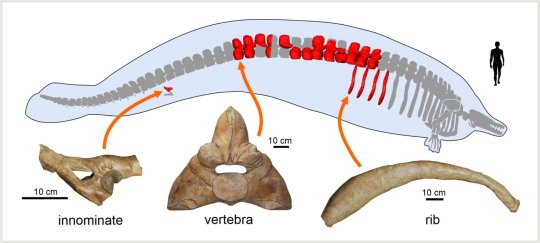
I know I usually talk about crocs, but this is too good not to share. A new giant basilosaurid whale with weird anatomy from the Eocene of Peru.
Perucetus colossus is a peculiar animal. It's bones were incredibly thick and incredibly dense, very much unlike those of modern whales and even more extreme than even those of the thicker basilosaurids (aptly named Pachycetinae i.e. thick whales). These adaptations have been compared to modern manatees and dugongs.
Know the weight range is highly dependent on what you base the math on. Using manatees as a proxy, you get a weight of "only" 85 tons....using extreme values for whales a whopping 340 tons. Mean values for whales a still really big 180 tons. This could indicate that Perucetus rivaled the Blue Whale as the worlds heaviest animal ever.
The ecology is poorly understood tho. We know basilosaurids preferred coastal waters, and with all the similarities to manatees it is reasonable to assume that Perucetus was a shallow water animal itself. It also likely wasn't the fastest swimmer. And the lack of a skull basically means we can't say much on its diet. We can wager a guess and say it wasn't a predator because, you know....it also likely wasn't a grazer. Cool as it would be, we don't really have herbivorous whales like that so its incredibly unlikely. The two more likely suggestions are that it lived on small animals burried in the ocean floor, sorta like a grey whale. Or that it was a scavenger like a sleeper shark (tho I find that suggestion far less likely, giving me scavenging T.rex vibes ngl). But again, once we get a skull we can talk about this better.
Sidenote I do find the name a little underwhelming. It's a bizarre animal and the best we could come up with is "Colossal whale from Peru". I'm also not a mammal person, but from what I'm being told the silhouette is a little exaggerated and it wasn't necessarily that thick in life.
Life reconstruction by A. Gennari, paper can be found here
A heavyweight early whale pushes the boundaries of vertebrate morphology | Nature
#perucetus#basilosauridae#paleontology news#palaeoblr#prehistory#eocene#early whale#evolution#science#whale
2K notes
·
View notes
Text



hello basilosaurid nation i have been thinking about the perucetus colossus and his tiny little legs !
[id: three drawings of a whale-like animal. they are roughly seal-shaped in terms of body, with a round flat tail and a small protruding oval head. all three have small back legs and feet. the first, coloured purplish, has flipper-like anterior appendages. the second, coloured blue, has big hands at the end of long, wide arms. the third is greenish, and has traditional finger-less whale fins. end id]
159 notes
·
View notes
Text
Yo I nearly didn't realize it was International Ace Day, and THEN I nearly forgot I had this art I did a few years ago, and honestly not only do I need to finish this set (Paleo-pride, all Paleo critters in fun pride colors!) but I also just need to share them more bc I'm very proud of them???
Anyway, pls enjoy this BasilACEsaur!!!

#ace#asexual#asexuality#international asexuality day#paleontology#paleoart#basilosaurus#basilosauridae#basilACEsaurus
650 notes
·
View notes
Text

While last week's Tutcetus was the smallest known basilosaurid whale, another recently-announced member of that group was almost the complete opposite.
Perucetus colossus was a chonker. An absolute unit of a whale.
Living during the Eocene (~38 million years ago) in shallow marine waters covering what is now the coast of Peru, this ancient whale is known from several vertebrae, ribs, and parts of its pelvis. As a result its full size is uncertain, but based on the proportions of other basilosaurids it was probably somewhere around 17-20m long (~56'-66') – similar in length to the larger specimens of Basilosaurus.
However, it had much thicker denser bones, even more so than those of its close relative Antaecetus, suggesting that its full body mass was much higher than the rather slender Basilosaurus – and possibly heavier than even modern blue whales despite being shorter in overall length.
Perucetus' thickened vertebrae were also fairly inflexible in most directions, indicating it was a sirenian-like slow swimmer with limited maneuverability – but it did have a surprisingly good ability to bend its body downwards. Without skull material it's unclear what its diet was like, but it may have been a suction-feeder hoovering up seafloor prey like modern grey whales or walruses.
I've reconstructed it here with a speculative bristly fleshy downturned snout inspired by the weird skull of Makaracetus, an earlier whale that may have also been a walrus-like bottom-feeder.
———
NixIllustration.com | Tumblr | Patreon
#science illustration#paleontology#paleoart#palaeoblr#perucetus#pachycetinae#basilosauridae#pelagiceti#archaeoceti#cetacean#whale#artiodactyla#ungulate#mammal#art#speculative reconstruction#i am predicting Weird Snoot Shenanigans for this chonkwhale#gotta have some very specialized feeding ecology going on there
390 notes
·
View notes
Text

Did another lorge whale warmup lol
I'm really taken with the idea of a huge benthic whale. I think it's because I've always been rather taken with steller's sea cows too.
I hope more fossils are found, I'd love a skill to confirm what kind of diet it had :'3
#art#sketch#drawing#animal drawing#doodle#warmup#perucetus colossus#basilosaurus#basilosauridae#paleoart#speculative biology#speculative reconstruction#big whale#like huuuge whale
91 notes
·
View notes
Text

Day 5: Pachycetus paulsonii
A extinct pachycetine basilosaurid (a primitive whale, not a lizard nor reptile) from middle Eocene of Europe and technically from USA as another species P. wardii.
#my art#paleoart#myart#my drawings#cetacean#basilosauridae#pachycetus#eocene#cenozoic#toned tan#sketchbook
21 notes
·
View notes
Text
Another impression of the giant Archaeocete Perucetus colossus, with the cow-sized Tutcetus and a frogman for comparison. The Archaeocetes of the Eocene surely came in all sorts of shapes and sizes, didn’t they?

65 notes
·
View notes
Text
Behold, the basilosaurus handbag

#paleontology#paleoart#my art#basilosaurus#basilosauridae#cetacean#whale#prehistory#prehistoric#Prehistoric whale#handbag#concept art
29 notes
·
View notes
Text

Beginning Paleovember 2023 with one of the BIGGEST finds of the year, Perucetus colossus! This early whale from the Eocene Epoch had unusually thick and dense vertebrae and rib bones, possibly indicating it stuck to the sea floor in shallow waters, similar to manatees. Estimates have put the weight of Perucetus from 85 to 350 tons, which would make it the heaviest animal to ever exist!
#paleontology#paleoart#paleomedia#perucetus#whale#basilosauridae#animal#fossil#Paleovember#illustration#art#artwork#cartoon#creaturedesign#procreate#artist on tumblr
41 notes
·
View notes
Text


I want to show you my Coco character with the absolute new design.
She was an orca, but I didn't really liked it or used that character. And because I've been studying prehistoric whales for a whale, I fell in love with basilosauridae and so. So I decided to change completelly her species and here we go.
Of course I kept simmilars patterns to orca. I had to. :> But I like her more this way. I felt like previous Coco was made in rush with "no love".
So instead of falling into void, I decided to redesign her. :>
Enjoy!
#artists on tumblr#artist on tumblr#my art#art#illustration#character sheet#basilosauridae#paleoart#prehistoric whale#whale#small artist#paleo art#my oc#my artwork#my original art
29 notes
·
View notes
Text

This mother Basilosaurus and her newborn calf are returning to the surface of the water for air.
Basilosaurus (King Lizard) was first described in 1834 and originally mistaken for a marine reptile, hence the name. Further study revealed it to be a massive marine mammal, and the first prehistoric whale known to science. This predatory cetacean from around 40 million years ago, has been estimated to measure up to 66 feet long, almost as long as the modern blue whale, the largest living animal. Basilosaurus and its relatives had become fully aquatic, with their massive bodies and much more whale-like flippers. They had vestigial back limbs and a pelvis leftover from their ancestors. Many whales today still have these vestigial limbs, although they're so small they are completely invisible outside the body.
#basilosaurus#paleoart#paleontology#evolution#whale evolution#whales#whale#cetacean#cetaceans#basilosauridae#eocene#paleogene
19 notes
·
View notes
Text
Pachycetinae: The Thick Whales
Oh look I'm way behind not only on my work with wikipedia but also in regards to summarizing it on tumblr. Good thing, three of the pages I've worked on these past few months can just be summed up in one post because they are all one family.
So Pachycetinae, at the most basic level, are basilosaurid archaeocetes, the group that famously includes Basilosaurus and Dorudon. Reason I've picked up the articles in addition to my usual croc work, basically a friend and I noticed how lacklustre many pages are and stupidly decided to start revising all of Cetacea (pray for me).
Currently theres two genera within the group. Pachycetus aka Platyosphys aka Basilotritus, which is a whole mess I will get into at the end for those interested, and Antaecetus, which I'll just call "the good one" for now. Among those are three species. Pachycetus paulsonii (or Basilotritus uheni) from continental Europe (Germany and Ukraine mostly), Pachycetus wardii (Eastern United Staates) and Antaecetus aithai (Morocco and Egypt)
Picture: Pachycetus and Antaecetus by Connor Ashbridge


So the hallmark of Pachycetines, as the name would suggest, is the fact that their skeletons are notably denser than that of other basilosaurids. The vertebrae, the most abundant material of these whales, are described as pachyostatic and osteosclerotic. The former effecitvely means that the dense cortical bone forms thickened layers, while the latter means that the cortical bone, already forming thickened layers, is furthermore denser than in other basilosaurids with less porosities. The densitiy is increased further by how the ribs attack to the vertebrae not through sinovial articulation but through cartilage, so adding even more weight to them. Overall this is at times compared to manatees, famous for their dense skeletons.
Pictured below, the currently best preserved pachycetine fossil, an individual of the genus Antaecetus from Morocco.

Now there are some interesting anatomical features to mention that either differ between species or just can't be compared. For example the American species of Pachycetus, P. wardii, shows a well developed innominate bone, basically the fused pelvic bones. This is curious as one would think of it as a more basal feature, with derived whales gradually reducing them. The skull is best preserved in Antaecetus and has a very narrow snout. One way to differentiate the two is by the teeth. Pachycetus has larger, more robust teeth while that of Antaecetus are way more gracile and is thought to have had a proportionally smaller skull (in addition to being smaller than Pachycetus in general).
All of this has some interesting implications for their ecology. For instance, why the hell are they so dense? Well its possible that they were shallow water animals using their weight as ballast, staying close to the ocean floor. This would definitely find some support in the types of environments they show up in, which tend to be shallow coastal waters. There are some Ukrainian localities that suggest deeper waters, but that has been interpreted as being the result of migration taking them out of their prefered habitat.
Now while pachycetines were probably powerful swimmers, their dense bones mean that they were pretty slow regardless. And to add insult to injury, they were anything but maneuverable. Remember those long transverse processes? Turns out having them extend over the majority of the vertebral body means theres very little space for muscles in between, which limits sideways movements.
From this one can guess that they weren't pursuit predators and needed to ambush their prey. What exactly that was has been inferred based on tooth wear. Basically, the teeth of Pachycetus show a lot of abrasion and wear, not dissimlar to what is seen in modern orcas that feed on sharks and rays. And low and behold, sharks are really common in the same strata that Pachycetus shows up in. Now since Antaecetus had way more gracile teeth, its thought that it probably fed on less well protected animals like squids and fish.
Below: Pachycetus/Basilotritus catching a fish by @knuppitalism-with-ue

The relationship between pachycetines and other basilosaurids is wonky, again no thanks due to Pachycetus itself being very poorly known. Some studies have suggested that they were a very early branching off-shoot, in part due to their prominent hip bones, but in the most recent study to include them, the description of Tutcetus, they surprisingly came out as not just the most derived basilosaurids but as the immediate sister group to Neoceti, which includes all modern whales. Regardless, in both instances they seem to clade closely with Supayacetus, a small basilosaurid from Peru.
And now for the part that is the most tedious. Taxonomy and history.
Remains of pachycetines have been known for a while and were first described as early as 1873 by Russian scientists. To put into perspective how old that is. The material's history in science predates both World Wars, the collapse of the Russian Empire and even the reign of Tsar Nicholas II. Now initially the idea was to name the animal Zeuglodon rossicum, but the person doing the actual describing changed that to Zeuglodon paulsonii reasoning that it would eventually be found outside of Russia (something that aged beautifully given that Ukraine would eventually become independent).
And this is where the confusion starts to unfold. Because at the same time people unearthed pachycetine fossils in Germany too, which would come be given the name Pachycetus (thick whale) and be established as two species. Pachycetus robustus and Pachycetus humilis, both thought to be baleen whales.
Pictured below: Pierre-Joseph van Beneden who coined Pachycetus and Johann Friedrich Brandt who described Zeuglodon paulsonii. Beneden easily has the better beard.
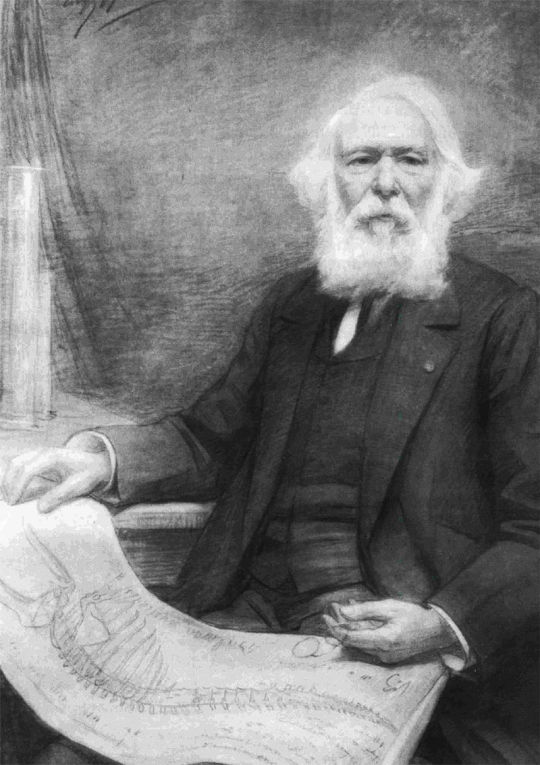

These latter two names however were later rejected in 1935 by Kuhn and lumped into other species, whereas Zeuglodon paulsonii was elevated to a full on new genus by Remington Kellogg in 1936. For those curious, Platyosphys means "broad loin", in combination with the species "Paulson's broad loin" to the amusement of some friends of mine.
And then people stopped caring and we have a nearly 70 year research gap. Eventually Mark D. Uhen found fossil material in the United States, but interpreted those fossils as being part of the genus Eocetus, naming them Eocetus wardii, a move that many following researchers disagreed with.
Then in 2001 a new species of Platyosphys, P. einori, was named. It's bad, moving on. More importantly, we got the works of Gol'din and Zvonok, who attempted to bring some clarity into the whole thing. To do so they rejected the name Platyosphys on account of the holotype having been lost sometime in WW2 and picked out much better fossil material to coin the genus Basilotritus ("the third king" in allusion to Basilosaurus "king lizard" and Basiloterus "the other king", isn't etymology fun?). They erected the type species Basilotritus uheni and then proclaimed Eocetus wardii to also belong into this genus, making it Basilotritus wardii.
This move was however not followed by other researchers. Gingerich and Zhouri maintained that regardless of being lost, Platyosphys is still valid and can be sufficiently diagnosed by the original drawings from the 19th and early 20th century. And to take a step further they added a new species, Platyosphys aithai (weird, why does that name sound familiar).
Then Van Vliet came and connected all these dots I've set up so far, noting that the fossils of Platyosphys are nearly identical to those of Pachycetus. This lead to the fun little thing were "paulsonii", applied first to Zeuglodon in the 1870s, takes priority over "robustus", coined just a few years later, BUT, the genus name Pachycetus easily predates Platyosphys by a good 60 years. Subsequently, the two were combined. Platyosphys paulsonii and Pachycetus robustus became Pachycetus paulsonii (simplified*). Van Vliet then deemed humilis to be some other whale and carried over Basilotritus uheni, Basilotritus wardii and Platyosphys aithai into the genus Pachycetus. *Technically Pachycetus robustus was tentatively kept as distinct only because of how poorly preserved it was, making comparisson not really possible.
Then finally in the most recent paper explicitly dealing with this group, Gingerich and Zhouri came back, killed off P. robustus for good, sunk Pachycetus uheni into Pachycetus paulsonii for good measure and decided to elevate Pachycetus aithai to genus status after finding a much better second skeleton, coining Antaecetus (after the giant of Greek myth).
And that's were we are right now. Three species in two genera, but only one of them is actually any good. So perhaps at some point in the future we might see some further revisions on that whole mess and who knows, perhaps Basilotritus makes a glorious comeback.
To conclude, sorry about the lack of images, despite the ample history theres just not much good material aside from that one Antaecetus fossil and I didn't want to include 5 different drawings in lateral view.
Obligatory Wikipedia links:
Pachycetinae - Wikipedia
Antaecetus - Wikipedia
Pachycetus - Wikipedia
Ideally Supayacetus will be the next whale I tackle, distractions and other projects not withstanding (who knows maybe I'll finally finish Quinkana)
#pachycetinae#pachycetus#basilotritus#platyosphys#antaecetus#archaeocete#prehistory#paleontology#palaeoblr#basilosauridae#eocene#whale
157 notes
·
View notes
Text
While blue whales are sleek, fast-swimming divers, Perucetus was a very different beast. The researchers suspect that it drifted lazily through shallow coastal waters like a mammoth manatee, propelling its sausage-like body with a paddle-shaped tail.
“This is a weird and stupendous fossil, for sure,” said Nicholas Pyenson, a paleontologist at the Smithsonian National Museum of Natural History, who was not involved in the study. “It’s clear from this discovery that there are so many other ways of being a whale that we have not yet discovered.”
The head of Perucetus would have adaptations for whichever way of life it pursued. “I would love to see the skull of this guy,” Dr. Thewissen said.
excerpts from the NYT article about the Perucetus colossus by Carl Zimmer
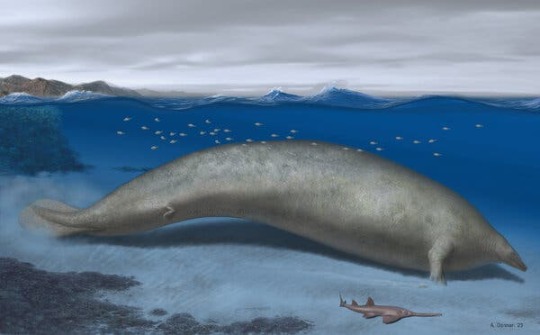
(illustration by Alberto Gennari, 2023)
#SO MANY OTHER WAYS OF BEING A WHALE#PROPELLING ITS SAUSAGE-LIKE BODY WITH A PADDLE-SHAPED TAIL#I WOULD LOVE TO SEE THE SKULL OF THIS GUY#basilosauridae#basilosaurid#perucetus#perucetus colossus#paleoblr
172 notes
·
View notes
Text
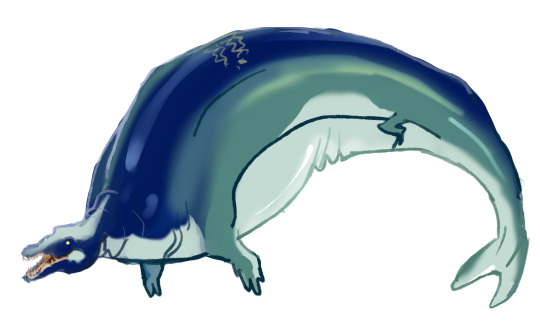

Thick whale! Chunky whale!
+ with a inverted-head coloring, just find it creepy
23 notes
·
View notes
Text
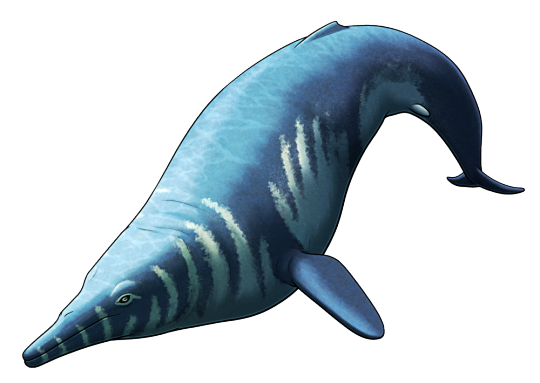
Tutcetus rayanensis was a whale that lived in warm shallow tropical seas covering what is now Egypt during the Eocene, about 41 million years ago.
It was an early member of the "basilosaurids", a grouping made up of multiple early cetacean lineages (an "evolutionary grade") representing some of the first fully aquatic forms. Like other members of this group it probably would have had a rather long and slender body shape – but unlike most of its relatives Tutcetus was comparatively tiny, estimated to only have been around 2.5m long (~8'2").
The fusion of the skull bones in the one known fossil specimen indicate it was almost fully grown at the time of its death, and the pattern of tooth replacement suggests this small basilosaurid species matured very rapidly – a sort of "live fast, die young" life strategy.
Tutcetus' small size and early demise also inspired its genus name, with "Tut" referencing the teenage Egyptian Pharaoh Tutankhamun.
———
NixIllustration.com | Tumblr | Patreon
#science illustration#paleontology#paleoart#palaeoblr#tutcetus#basilosauridae#cetacean#whale#artiodactyla#ungulate#mammal#marine mammals#art
360 notes
·
View notes
Text

PERUCETUS COLOSSUS
When I read about this news, I was amazed. Actually, I'm working on a personal research. I want to create my own encyclopedia on whale ancestors. I'm really addictive to them. The more I learn, more I'm interested. So, if you have any recommandations for my readings, searchings, I'll take it!
Now that I know this new one, I can't wait to be able to read the official scientific article.
This animal could be the heaviest... EVER! More than the blue whale! Incredible, don't you think ?
Picture : (c) hyrotrioskjan on Deviantart
#whale#whales#perucetus#perucetus colossus#ancestors#peru#cetaceans#archeocete#eocene#extinct animals#extinct species#extinct#heavy#basilosauridae#basilosauridés#baleine#baleines#archeoceti#archéocètes#paleontology#fossils#fossile#fossil#prehistoric#prehistoric life
22 notes
·
View notes